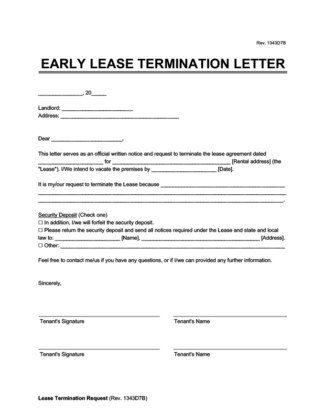
Use our early termination of lease agreement to politely request that your landlord allow you to break a lease agreement early.

Updated July 11, 2024
Written by Sara Hostelley | Reviewed by Susan Chai, Esq.
An early lease termination letter is a document a tenant sends to a landlord to formally request an early termination of a lease agreement. While landlords are not legally required to terminate a lease early, a letter may convince them to do so.
Sending an early lease termination letter is a polite and intelligent way to begin discussing your situation with your landlord.
Here are some scenarios to use an early lease termination letter:
Please remember to issue proper notice as dictated by local laws and your original lease.
Unless you have unique circumstances for moving out early, like active military duty or the landlord’s failure to keep the premises livable, you may have to pay rent for the rest of the lease.
However, you may be able to break your lease agreement early by following these steps:
Review your original lease to see if it covers protocols for terminating your lease agreement early. For example, you may have to provide a certain amount of days’ advance notice to your landlord before breaking the rental term. Abide by all instructions and requirements to make your request easier to accept.
Compose an early lease termination letter explaining why you must end the lease prematurely. For example, you may need to break the lease because you lost your job, got divorced, or need to care for a sick family member.
Landlords don’t have to comply with an early termination request originating from personal reasons, but they may sympathize with your need to break the lease if you explain it in your letter.
Send the letter to your landlord as soon as possible to give them ample written notice. You can hand-deliver it or send it via certified mail.
Please make a copy of your early lease termination letter and note when your landlord received it. Keep it in your records to show that you provided adequate notice to vacate the rental property early.
Prepare to negotiate the terms of ending the lease early. Early termination may not come without penalties, but you can negotiate the following items:
If your landlord refuses to let you terminate the lease early, ask if you can sublet the property. By subletting, you can move out and continue collecting rent from a subtenant. You can use their rent payments to pay your landlord. Subletting relieves the landlord of finding a replacement tenant, making the request more agreeable.
If the current lease agreement forbids subletting, you can ask the landlord to use a lease amendment to modify the agreement.
As the current tenant, you would use a sublease agreement to rent the property to a subtenant.
Some provisions in state laws allow tenants to break lease agreements early, such as if they suffer domestic abuse (for example, review Cal. Civ. Code § 1946.7 if you rent property in California).
Review your state’s laws and contact a lawyer for assistance in locating these loopholes.
Lease termination letters should include all of the following elements:
If your landlord doesn’t offer a reprieve and you’re not ending your lease for a valid reason under the original agreement, you may experience the following penalties:
Explore some circumstances in which a tenant may be able to break a lease early without penalties:
Provide the landlord’s full name and the party who owns the leased or rented property. Write the landlord’s current address. (Note: This is not the address of the property the tenant is renting.)
Insert the date the tenant entered into the original lease agreement (in most cases, it’s the date the landlord and tenant(s) signed the lease agreement).
Provide the street address of the property that is being leased. Include the unit or apartment number if applicable. Enter the date the tenant plans to move out of the property.
Provide the reason the tenant wants to terminate the lease agreement, such as a job relocation or a significant family change like divorce or death. While providing the reason is optional, landlords may be more willing to end a lease early if they know the tenant’s circumstances or hardships.
In most cases, the tenant paid a security deposit at the beginning of the lease. The tenant can forfeit, request a return, or request another action regarding the security deposit. Remember that depending on your situation, the landlord may not return the security deposit.
Write the full name and address where the landlord should forward the security deposit.
Provide the full name of each tenant who signed the original lease agreement and any subsequent tenants added to the lease through lease amendments or lease addendums.
Download an early lease termination letter template in PDF or Word format below: